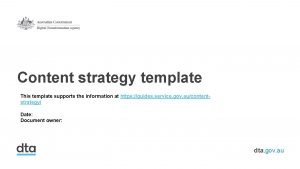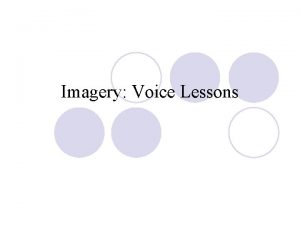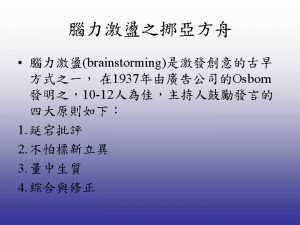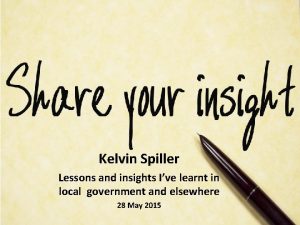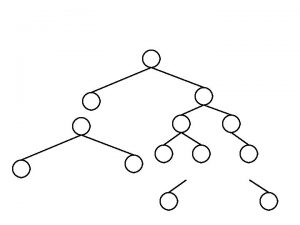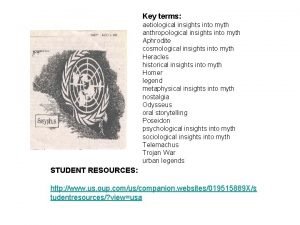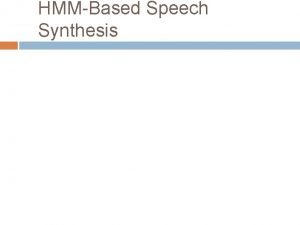A SYNTHESIS OF KEY INSIGHTS AND LESSONS LEARNT










- Slides: 10

A SYNTHESIS OF KEY INSIGHTS AND LESSONS LEARNT FROM COUNTRIES WHO HAVE USED REGISTERS & ADMIN DATA IAN COPE

COUNTRIES USING REGISTERS IN CENSUS 2010 ROUND Registers only • Nordic Countries - Denmark, Norway, Sweden, Finland • Austria, Belgium, • Slovenia, Turkey, Iceland Registers and Sample surveys • Spain, Germany, The Netherlands, Poland, Switzerland, Israel Registers and traditional census • Czech Republic, Latvia, Lithuania

COMMON FRAMEWORK FOR REGISTER AND COMBINED CENSUSES

REGISTER BASED CENSUSES UNIFIED IDS ACROSS SYSTEMS • A key enabler for the statistical use of register data records is unified identification systems (IDs) across different register sources • Those countries with register based censuses all have Person ID systems and National Population Registers • with the same person ID used consistently across registers • In these countries unique identifiers are widely used for other registers like the business register and the registers on addresses, buildings and dwellings. • Without unique IDs used across registers it is more difficult to link different registers • Although countries such as the UK and New Zealand have linked successfully without a unified ID • But this is less certain and more complex

LINKAGE OF INDIVIDUALS BETWEEN REGISTERS • Models used include: • Linkage in the clear (e. g. a database holding identifiers and characteristic variables), and • Trusted Third-Party (TTP) linkage models • The Trusted Third-Party linkage model is the most common: • Identifiers linked between registers and the pop register by TTP; a statistical identifier is created, attribute data extracted from source register • Attribute data linked using the statistical identifier • ONS/Stats NZ use this approach – linking on Name, Date of Birth, Address etc • TTP - records from individual registers linked together without personal identifier information being included in the data file • thereby preserving confidentiality and privacy

KEY REGISTERS Three key administrative base registers: • Register on persons (population register) • Foundation for a pop register and ID system is a civil registration system • Critical that investments are made in these systems to ensure that they are of good quality, universal, continuous, permanent and compulsory. • Address Register (real estate, buildings and dwellings) • Business register With three associated statistical base registers: • Address is the link between the population/property registers; and business/buildings registers – giving location of residence and work • Other census variables come from registers on health, jobs, educational activities, tax, wages and salaries etc • but they are not base registers • In Nordic counties almost all specialised registers use the same ID key as the relevant base register - linking is thus normally straightforward

STEP-BY-STEP DEVELOPMENT The development process is the same across all countries using registers or admin data: 1 Ensure legislation in place to allow sharing of admin data with the NSO 2 Ensure that there is public trust/support for the use of registers/admin data 3 Develop positive relationships with register/admin data owners 4 Develop a linkage model 5 Produce an Address Register – align to concept of household in census 6 Produce a Statistical Population Register 7 Produce regular population estimates for local areas 8 Different subject matter statistics were developed, tested, and published • e. g. education, employment

STEP-BY-STEP DEVELOPMENT 9 Introduce register-based variables in the census when quality good enough 10 - When statistics developed for all areas relevant for censuses, a totally register based census could be conducted 11 Developments in IT enable the time span between establishing admin registers and their use in official statistics to be reduced • Nordic countries took 30 years to develop fully register based censuses • Austria made transition from traditional census to a full register census in 10 years • with strong political, government and public support 12 Even today, the process will take time • Building systems and teams; quality assurance; setting up reporting procedures (may not work perfectly at first); etc

• It’s important to start – you will gain experience and learn lessons • Will take time to put in place data supply agreements, Mo. Us etc. • Take politicians and the public with you – sell benefits and protections • Business Registers likely in place; focus on Address Register and Population Register • Determine next priority – what high value admin data available?

A SYNTHESIS OF KEY INSIGHTS AND LESSONS LEARNT FROM COUNTRIES WHO HAVE USED REGISTERS & ADMIN DATA IAN COPE
 Content governance template
Content governance template Diction vs detail
Diction vs detail Voice lessons diction answer key
Voice lessons diction answer key Section 12-3 rna and protein synthesis
Section 12-3 rna and protein synthesis Business model
Business model Contoh bisnis model canvas makanan pdf
Contoh bisnis model canvas makanan pdf What have you learnt from the story
What have you learnt from the story What have we learnt from the story? *
What have we learnt from the story? * What have we learnt from the story?
What have we learnt from the story? What have we learnt from the story
What have we learnt from the story What have we learnt from the story
What have we learnt from the story
